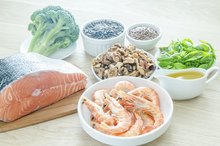What does fact checked mean?
At Healthfully, we strive to deliver objective content that is accurate and up-to-date. Our team periodically reviews articles in order to ensure content quality. The sources cited below consist of evidence from peer-reviewed journals, prominent medical organizations, academic associations, and government data.
- Linus Pauling Institute at Oregon State University: Essential Fatty Acids
- American Heart Association: Fish 101
- U.S. Food and Drug Administration: What You Need to Know About Mercury in Fish and Shellfish
- MedlinePlus: Methylmercury Poisoning
The information contained on this site is for informational purposes only, and should not be used as a substitute for the advice of a professional health care provider. Please check with the appropriate physician regarding health questions and concerns. Although we strive to deliver accurate and up-to-date information, no guarantee to that effect is made.
Can a 1-Year-Old Eat Canned Tuna Fish?
You can offer fish to your baby as early as 6 months of age, reports pediatrician Frank Greer on the BabyCenter website 16. Tuna is an excellent choice because it’s packed with nutrients. Canned tuna fish is easy to serve and a healthy option for your child, but don’t feed him fish every day because it contains mercury, which could pose a health risk to your little one. Fish is also a common allergen in children, so beware of any signs of an allergy and speak to your pediatrician if you’re concerned.
Benefits of Tuna Fish
Omega-3 fatty acids are a vital part of your child’s brain and eye development. Few foods provide your child with omega-3 fatty acids, and your body best absorbs them through foods rather than supplements. Canned tuna contains 0.17 to 0.24 gram of omega-3s per 3-ounce serving, or 24 percent to 34 percent of the recommended amount. Tuna fish is also low in saturated fat and rich in high-quality protein and other essential nutrients, including B vitamins, phosphorous and niacin.
- Omega-3 fatty acids are a vital part of your child’s brain and eye development.
- Few foods provide your child with omega-3 fatty acids, and your body best absorbs them through foods rather than supplements.
Risk Factors
Side Effects of Omega 3 in Children
Learn More
Mercury is a toxin that enters oceans and streams and becomes methylmercury. Fish absorb methylmercury, and your body absorbs it when you eat fish. How much you absorb depends upon the levels of mercury in the fish you’re eating. Larger fish tend to have higher amounts than smaller fish, and toxins are generally more potent in babies and toddlers. Mercury acts as a neurotoxin by potentially damaging your child’s brain and developing nervous system. According to MedlinePlus, methylmercury poisoning is believed to cause a form of cerebral palsy 7. Symptoms include deafness, blindness, small head circumference and poor growth.
- Mercury is a toxin that enters oceans and streams and becomes methylmercury.
- Fish absorb methylmercury, and your body absorbs it when you eat fish.
Serving Size
Limit your 1-year-old’s intake of chunk light tuna to two servings a week and albacore tuna to one serving a week. A serving size for a 1- to 2-year-old is 1 ounce. Albacore is a larger fish, so it has a higher mercury content than the skipjack fish used to make chunk light tuna. Check the label for chunk light tuna, though, because sometimes it’s made with yellowfin, which is higher in mercury. Don’t completely eliminate albacore tuna from your child’s diet. It contains more omega-3s than chunk light tuna, so there is a nutritional benefit to serving your child albacore tuna from time to time.
- Limit your 1-year-old’s intake of chunk light tuna to two servings a week and albacore tuna to one serving a week.
- It contains more omega-3s than chunk light tuna, so there is a nutritional benefit to serving your child albacore tuna from time to time.
Allergy Signs
Salmon & Skin Rash
Learn More
Fish is on the list of top allergenic foods in babies and young children. If you have a history of family allergies, speak with your pediatrician before feeding tuna to your child. Don’t introduce any other new foods on the day you introduce fish and watch out for signs of an allergy. Symptoms include swelling, wheezing, vomiting and diarrhea. If you notice anything, call your doctor immediately.
- Fish is on the list of top allergenic foods in babies and young children.
- If you have a history of family allergies, speak with your pediatrician before feeding tuna to your child.
Related Articles
References
- BabyCenter: When Can My Baby Eat Fish?
- Linus Pauling Institute at Oregon State University: Essential Fatty Acids
- American Heart Association: Fish 101
- U.S. Food and Drug Administration: What You Need to Know About Mercury in Fish and Shellfish
- BabyCenter: Should Your Kids Eat Fish?
- MedlinePlus: Methylmercury Poisoning
- USDA National Nutrient Database: Fish, Tuna, Light, Canned in Water, Drained Solids
- Fish, tuna, light, canned in water, without salt, drained solids. FoodData Central. U.S. Department of Agriculture. Published April 1, 2019.
- Dhurmeea Z, Pethybridge H, Appadoo C, Bodin N. Lipid and fatty acid dynamics in mature female albacore tuna (Thunnus alalunga) in the western Indian Ocean. PLOS ONE. 2018. doi:10.1371/journal.pone.0194558
- Vitamin B12 or folate deficiency anaemia. National Health Service. Updated 2019.
- Sparkes C, Gibson R, Sinclair A, Else PL, Meyer BJ. Effect of low dose docosahexaenoic acid-rich fish oil on plasma lipids and lipoproteins in pre-menopausal women: A dose⁻response randomized placebo-controlled trial. Nutrients. 2018;10(10). 10.3390/nu10101460
- Simonetto M, Infante M, Sacco RL, Rundek T, Della-Morte D. A novel anti-inflammatory role of omega-3 PUFAs in prevention and treatment of atherosclerosis and vascular cognitive impairment and dementia. Nutrients. 2019;11(10). doi:10.3390/nu11102279
- Damanti S, Azzolino D, Roncaglione C, Arosio B, Rossi P, Cesari M. Efficacy of nutritional interventions as stand-alone or synergistic treatments with exercise for the management of sarcopenia. Nutrients. 2019;11(9). doi:10.3390/nu11091991
- Diabetes superfoods. American Diabetes Association. Updated 2020.
- Histamine toxicity. American Academy of Allergy, Asthma & Immunology. Updated 2020.
- ACOG practice advisory: Update on seafood consumption during pregnancy. American College of Obstetricians and Gynecologists. Updated 2017.
- Canned tuna. Seafood Health Facts: Making Smart Choices Balancing the Benefits and Risks of Seafood Consumption. Updated 2020.
- Selecting and serving fresh and frozen seafood safely. U.S. Food and Drug Administration. Updated 2019.
Writer Bio
Michelle Fisk began writing professionally in 2011. She has been published in the "Physician and Sports Medicine Journal." Her expertise lies in the fields of exercise physiology and nutrition. Fisk holds a Master of Science in kinesiology from Marywood University.









